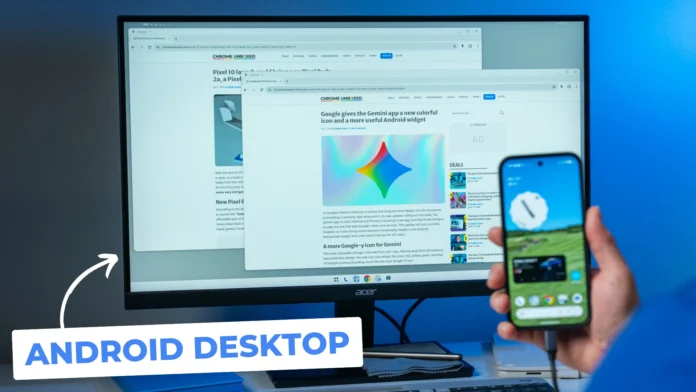Contents
Android 16 Desktop Mode Hands-On: A Glimpse into the Future of Mobile Productivity
The latest beta version of Android 16 has introduced a true desktop mode, allowing users to plug their phone into a monitor and experience a PC-like interface. This feature has been a long-awaited dream for many Android users, and we’ve managed to get it up and running to show you what it looks and feels like. While it shows promise, it’s clear that ChromeOS isn’t going anywhere anytime soon.
The latest beta version of Android 16 has been making waves in the tech community, and for good reason. The introduction of a true desktop mode has been a highly anticipated feature for Android users, and we’ve finally gotten our hands on it. But what does this mean for the future of Android and ChromeOS? To answer this, let’s take a closer look at the new desktop mode and how it works. The who, what, where, when, why, and how of this feature are all important questions that need to be addressed. Who is this feature for? What are its capabilities and limitations? Where can you use it? When will it be available to the public? Why is it important? And how does it work?
How to Try Android 16 Desktop Mode Yourself
If you’re feeling adventurous, you can try out the new desktop mode for yourself. To do this, you’ll need a compatible Pixel phone that supports display out over USB-C, such as the Pixel 9 Pro XL or the Pixel 8 series. Here are the steps to follow:
* Opt into the Android 16 Beta Program at google.com/android/beta
* Enable Developer Options on your phone
* Turn on all the window management toggles, such as “enable freeform windows”
* Reboot your phone
* Connect your phone to an external monitor using a USB-C to HDMI dongle or hub
A quick word of warning: this is a very early beta, and you may encounter some issues such as screen flickering. Patience is key if you want to try this out.
The Good, the Bad, and the Buggy
Once you’ve managed to get the desktop mode up and running, you’ll be greeted with a familiar yet raw interface. The good news is that the core windowing system works, allowing you to open apps in free-form windows, resize them, and snap them to either side of the screen. The overview mode also seems to function like virtual desks, keeping your window layouts grouped together. However, the limitations are immediately apparent. The experience is visually stark, with no wallpaper support yet, making it look unfinished. More critically, the text on the screen can be blurry and difficult to read, which would be fatiguing for extended work sessions.
Some of the key highlights of the Android 16 desktop mode include:
* Free-form windows that can be resized and snapped to the side of the screen
* Overview mode that functions like virtual desks
* Ability to connect to an external monitor using a USB-C to HDMI dongle or hub
* Raw and unfinished interface with no wallpaper support
* Blurry and difficult-to-read text on the screen
Why ChromeOS Isn’t Going Anywhere Anytime Soon
While the new desktop mode is an exciting development, it’s clear that ChromeOS isn’t going anywhere anytime soon. The lack of a true desktop browser with extensions is a massive hurdle for real productivity. As Google works on a true desktop version of Chrome for Android and continues to refine this experience, many of these pain points will be solved. But for now, the new Android 16 desktop mode is a fascinating and fun tech demo, rather than a replacement for your Chromebook.
According to Google, the Android 16 desktop mode is still in its early stages, and it will take time to develop and refine. As Robby Payne, a tech expert, notes, “The new desktop mode is a great start, but it’s not yet ready for prime time. It’s a glimpse of an exciting future, but it’s not a replacement for your Chromebook today.”
Join the Conversation
If you’re interested in learning more about the Android 16 desktop mode and other tech news, be sure to join the conversation. You can subscribe to our newsletter or join our membership community, Chrome Unboxed Plus, to get access to exclusive benefits and stay up-to-date on the latest developments.
Conclusion:
The Android 16 desktop mode is an exciting development that shows promise for the future of mobile productivity. While it’s not yet ready for prime time, it’s a fascinating and fun tech demo that gives us a glimpse of what’s possible. As Google continues to refine and develop this feature, we can expect to see significant improvements and a more seamless user experience. For now, ChromeOS remains the better option for laptop-style work, but the future is looking bright for Android users.
Keywords:
* Android 16
* Desktop mode
* Mobile productivity
* ChromeOS
* Pixel phone
* USB-C to HDMI dongle or hub
* Free-form windows
* Overview mode
* Virtual desks
* Wallpaper support
* Text readability
* Chrome browser
* Extensions
* Laptop-style work
Hashtags:
* #Android16
* #DesktopMode
* #MobileProductivity
* #ChromeOS
* #PixelPhone
* #USBCtoHDMIdongleorhub
* #FreeFormWindows
* #OverviewMode
* #VirtualDesks
* #WallpaperSupport
* #TextReadability
* #ChromeBrowser
* #Extensions
* #LaptopStyleWork
Source link
